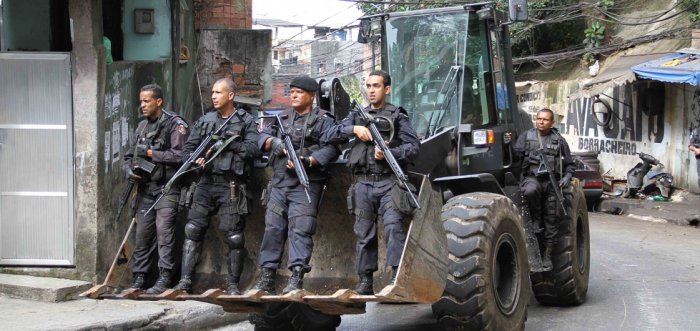
In a grainy camera image captured from a car windscreen, a limp body hangs from the boot of a moving vehicle in front, its head grinding with horrific speed on the bitumen. This was a woman named Claudia Ferreira—she lived in a Brazilian slum, she was black, and no other part of who she was meant anything to the military police that did this to her. This gut-wrenching crime by supposed crime-stoppers is only a prelude in Dan Jackson’s documentary In the Shadow of the Hill, which centres on the protests against the infamous, unsolved disappearance into police custody of local bricklayer Amarildo de Souza. The “hill” Amarildo hailed from is a Rio de Janeiro favela called Rocinha, and with the 2014 FIFA World Cup and 2016 Olympics looming, its residents were subject to a tidal wave of systematic oppression under the government-led pretense of a “pacification” program launched in 2011. These actions were meant to cleanse the area of drug-trafficking armies, but they only worsened the peril by turning innocent people like Amarildo and Claudia into disappeared victims of police interrogation and torture, as their justice-seeking families tell us themselves in this powerful and humane feature.
Jackson’s camera captures the darkened majesty of the city with large frames, and then glides through the thin alleyways and clustered balconies of the Rocinha neighbourhood. In cutting these images to local music and interview excerpts, the community proves so tightly bonded that “family” becomes a broad term. The members we meet in extensive talking-head conversations comprise of Amarildo’s relatives, headed by his niece Michelle Lacerda, along with defiant artist Aureilo Musquita, who is staging a Passion play with Rocinha-specific reference called Via Sacra, and lifelong resident Maria Clara. All are involved in some way with peacefully combating the urban warfarce tactics of the pacification squad, BOPE, and its leader Major Edson; a protest effort largely co-ordinated through local news media by human rights advocate João Tancredo, who we see attending the recreation of Claudia’s kidnapping. Relatively scarce mention is made of the traffickers that gave them reason to claim Rocinha in the first place, but there’s enough to know that the criminal threat they posed is dwarfed by the authorities’ annihilation of civil liberties. Jackson makes sure of this by completely effacing himself and his crew at every moment, demonstrating a vital trust in the people’s voices and his own creative fingerprints (he directs and shares producing, camera and editing credits here).1
With the spirit of belonging comes a climate of fear, and most of the film is a deep dive into the latter. Edson himself is present at town hall meetings and protests, stressing the normalisation of their hideous tactics better than any given soundbyte, and the consequences of it reach far beyond the fates of Claudia and Amarildo, with Aureilo facing a severe funding shortfall and Michelle’s activities instilling fearful silence in her neighbours. Hence, the triumphs presented later come as a great relief, though Jackson and company have their work cut out in balancing the hunt for Amarildo—which is itself part mystery procedural, part activist struggle—with the individual stories being shared.
There are neat segues made between parallel storylines, like in a tracking shot that pivots from Michelle to Maria as they pass each other in the street, but some plot turns feel like a cumbersome ball to juggle. For instance, when Maria emerges from BOPE-induced poverty as Lady Passionfruit, a satirical music act that takes the world by storm, it’s both a great relief in her troubled story and a very unexpected part of it that even the film seems unsure how to handle. The footage of her talent show audition is mapped onto a discarded TV set—a tidy stylising trick repeated for other instances of stock footage throughout the film—and then she guides us around the home she bought for herself and her children with that success. The narrative sprawl can feel busy, but the sensitivity and engagement with which it’s presented wins out.
The true culimination, built on the performance of Via Sacra and a protest march onto the governor’s home chanting “Where Is Amarildo?”, is configured as a galvanisation of the upper and lower classes of Rio through shared values. With stirring music and slow-motion, there’s a very climactic feel to these events that reads like Jackson and company reaching for a grand resolution, and while it’s drawn out and heightened in a way that clashes with the fraught events of before, it’s tempered with Michelle and company’s later cries for the many cases like theirs to receive the same attention. Overall, the tonal disparity is a small concession by the film-makers next to the enormity of their duty, and the fact that this may be inferred at all speaks to how valuable In the Shadow of the Hill is, as both a work of historical analysis and a celebration of impossible courage under fire.
